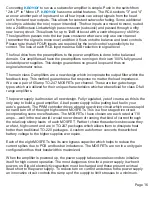
For those of you who have used our previous products, much of the information in this
manual will be familiar. We have added some new interesting titbits. Over the past four years
since the first Zed amplifiers were introduced, several events have occurred which have
moved us into a new dimension of mobile amplification.
The cost of gasoline has skyrocketed and for those of you who believe that $2.50 gasoline is
here to stay, well there is a big shock waiting just around that little corner. The world’s car
manufacturers are now forced to make smaller cars, as they have done for many years in
Europe and the far East. This means smaller electrical systems due to the smaller engines
are being used. Hybrids are cut from the same cloth in terms of the available electrical
power.
Well you may ask, what has this got to do with mobile amplifiers? Everything! The
electronics now must smaller, lighter, more efficient and of course less expensive.
Unfortunately these things do not always go hand in hand. The need for high powered
amplifiers has not diminished. Power hungry speakers and power hungry consumers prowl
the back alleys of mobile sound.
So what is required are amplifiers that use the available electrical power more efficiently
BUT with no loss of fidelity or power. Several options are available. Class B amplifiers are
notoriously inefficient due to the fact that they are linear devices and in their traditional form
waste about 70-80% of the power supplied to them as heat. Class A amplifiers do not even
think about for mobile use as their efficiency is even worse. So what options are available?
Class D is the one of them. For most audio buffs, class D has been given a bad rap owing to
the rash of really bad class D amplifiers which have been introduced to the mobile market
over the years. There are several reasons why these amplifiers sounded bad and were
unreliable. The bad sound was due to the fact that the designers/copycats had no idea on
how a class D amplifier functions. The reliability was due to bad design and almost zero
knowledge of class D amplifiers.
This technology has made leaps and bounds over the past 5 odd years. New semiconductor
devices have become available as well as a better understanding of this type of amplifier.
OK let’s get into some real “deep” issues. ALL amplifiers are basically power supplies! This
will shock almost all who read this. Audio amplifiers are really a valve between the actual
power supply and the speaker. This valve is “told” by the incoming audio signal to allow a
given amount of the v current from the power supply to reach the loudspeaker
dependent solely on the amplitude and polarity of the incoming signal. This may blow away
the pre conceptions of all who read this of what amplifiers really are. Remember there are
two main components in any amplifier, a power supply which is the sole source of power and
the “amplifier” which channels the power from the power supply by virtue of “commands”
given by the driving audio signal. With this said let’s see what’s cookin’ inside our black
boxes.
Page 1




































